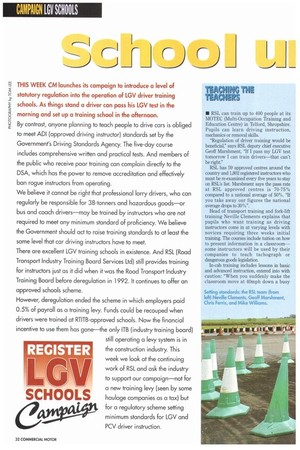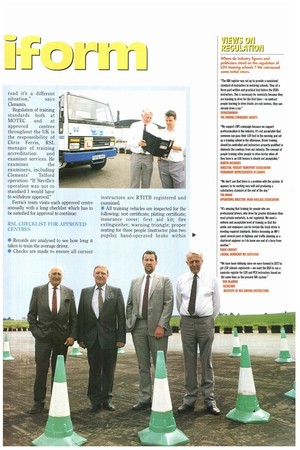• RSL can train up to 400 people at its
Page 34

Page 35

Page 36

If you've noticed an error in this article please click here to report it so we can fix it.
NIOTEC (Multi-Occupation Training and Education Centre) in Telford, Shropshire. Pupils can learn driving instruction, mechanics or removal skills.
"Regulation of driver training would be beneficial," says RSL deputy chief executive Geoff Marshment, "If I pass my LGV test tomorrow I can train drivers—that can't be right."
RSL has 59 approved centres around the country and 1,802 registered instructors who must be re-examined every five years to stay on RSL's list. Marshment says the pass rate at RSL approved centres is 70-75% compared to a national average of 50%. "If you take away our figures the national average drops to 30%".
Head of transport training and fork-lift training Neville Clements explains that pupils who want training as driving instructors come in at varying levels with novices requiring three weeks initial training. The courses include tuition on how to present information in a classroom— some instructors will he used by their companies to teach tachograph or dangerous goods legislation.
In-cab training includes lessons in basic and advanced instruction, entered into with caution: "When you suddenly make the classroom move at 40mph down a busy road it's a different situation," says Clements.
Regulation of training standards both at MOTEC and at approved centres throughout the UK is the responsibility of Chris Ferris, RSL manager of training accreditation and examiner services. He examines the examiners, including Clements' Telford operation: "If Neville's operation was not to standard I would have to withdraw approval."
Ferris's team visits each approved centre annually with a long checklist which has to be satisfied for approval to continue: RSL CHECKLIST FOR APPROVED CENTRES • Records are analysed to see how long it takes to train the average driver.
• Checks are made to ensure all current instructors are RTITB registered and examined.
• All training vehicles are inspected for the following: test certificate; plating certificate; insurance cover; first aid kit; fire extinguisher; warning triangle; proper seating for three people (instructor plus two pupils); hand-operated brake within
• instructor's reach; vehicles must be clean and tidy.
• Artics must have a proper catwalk on the tractor unit so trainees do not walk on diesel tanks.
• The centre must have a manoeuvring area within reasonable driving distance measuring 300x6Oft or five times the length of the fleet's longest vehicle. Written evidence of the centre's permission to use the area is required, • There have to be proper classroom facilities with heating, lighting, ventilation, desks. A portable building will suffice if it meets these requirements. Training aids are required such as dry white boards, overhead projectors, and a VCR—"A medium to deliver the theory", says Ferris.
• Centres are required to document driver assessment lessons in which instructors recommend length of training to employers. Attendance at lessons must be recorded with a certificate if required by employers.
• DOT examiner failure statements must be kept and analysed. If several trainees fail in their use of mirrors the fault could lie either with the training or, alternatively, a DSA examiner being over scrupulous.. This could result in a complaint to the DSA.
• Training programmes must be structured with a written summary of course content and a list of training sessions and their objectives.
• Training routes must be on written plans or clearly marked on maps.
If faults exist training centres are given a period of time to correct them otherwise approval can be withdrawn.
Marshment says it is difficult to prove whether there is a major safety problem because of uneven standards of LGV training in the UK. "The best argument for regulation is that people should be properly trained before getting to the test," he says, "an employer should be satisfied that he is buying a test which meets all the quality requirements."
Ferris argues that it is impossible for an instructor, however good, to operate properly without structured training and decent vehicles: "Without the support he can't do the job he should do."
Marshment is not in favour of returning to a training levy in the direct sense but he admires the French model where companies can put L5% of turnover into a training budget tax-free. He does, however, maintain that training in the UK at its best is better than elsewhere. "In France there are crew cabs with one instructor and four trainees—they take four weeks to complete the course which is a waste of time. In Denmark they take 13 weeks with the first four on theory and, ironically, they have the highest incidence of LGV accidents in Europe." Good training can save money in more ways than one. Mike Williams is RSL's instructor trainer in driver awareness and economical driving techniques. "One driver achieved a 17.5% fuel saving in a week by using the gears correctly and not using the double clutch method on a synchromesh gearbox"
Small tips can save lives: "Make sure the windscreen washer is topped up. A fatal WV accident costs the country ,E750,000 on average," says Williams,"my job is to draw the experience and knowledge from the back of their minds to the front."
RSL would like to develop these skills further and in partnership with the Freight Transport Association and training groups in France, Spain, Holland and Belgium is applying for European funding for defensive driver training.
E by Patric Cunnane
























































































































